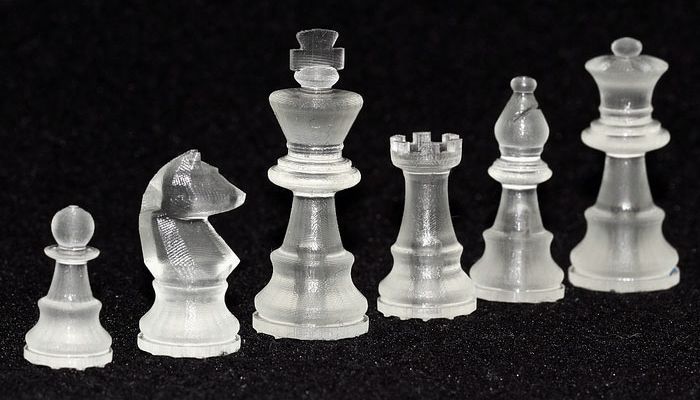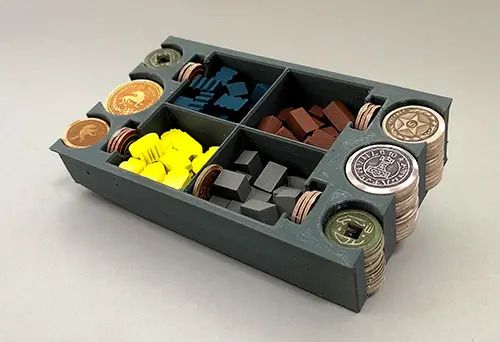A question that comes up from time to time is, “how strong is resin 3D printing?”. In this article, I’ll be trying to answer that question by looking at the various types of resin you can use for 3D printing, how strong and durable it can be and what are a of the best use cases for resin when deciding to 3d print.
So, let’s dive right in and take a look firstly at what resin 3D printing involves.
What is Resin 3D Printing?
Resin 3D printing is the common name for SLA (Stereolithography) printing and uses a completely different process to that of FDM (Fused Deposition Modelling) printing.
The resin itself comes in liquid form and is then subjected to UV light waves to form a solid object from a predetermined set of parameters defined by a digital design file. That’s my brief description of the general process and I won’t go into great detail about the actual way it works and what you need etc. You can however hopefully see what I mean in terms of the difference from FDM printing
The main focus of my attention here though is to look at the resins themselves and see what gives them their strength, what the different types do and when you should use them, and how post-processing can affect the strength.
Resin Types

In general, resin types can be grouped into two distinct areas of production for which they are used. These therefore would be:
· Standard: These would include those resins used by you or me as 3D printing hobbyists and easily available from many suppliers.
· Industrial: This group of resins would, as the name implies, be used more in the industrial and manufacturing sectors where high strength and density is required. There are a few types within this group but three good examples would be:
Heat Resistant: used in machinery and tools which need to withstand higher temperatures.
Burnout: used to fabricate metal items and then evaporate when hot metal is applied leaving a metal version of the original design.
Dental: used, unsurprisingly, in dentistry for creating smooth and economic dental prostheses. The resin itself is made from organic material so has no toxicity.
For now though, I want to focus on the standard group of resins as its more likely that you will be using these in your everyday 3D printing.
Again, as with industrial resins, there are a few main types that you might use:
Standard
This type of resin would be the most commonly used and I would describe it as the “PLA of resin printing”. PLA (Polylactic Acid) is the widely used filament in FDM printing and has properties that make it easy to work with both during printing and in post-processing.
Standard resin is fairly easy to work with but does require post-processing to make sure it cures (hardens) properly and to clean off any residue. This type of resin is ideal for beginners and is especially good for high detail and intricacy required for things like miniatures.
The downside with Standard Resin is that it is fairly fragile and can therefore break easily. That’s OK if you are just using it to print miniatures for gaming or figures for display, but it makes it unviable for tool making or small machine parts.
Water-Washable
This is pretty much the same as Standard Resin in terms of end product but there’s less post processing required. With Standard Resin, you need to use an IPA (Isopropyl Alcohol) solution to clean the object which is toxic and can give off fumes. With Water-Washable resin, you just need to clean the residue with water so there’s no need for precautionary safety measures to be taken. It also has lees odor which is associated with resin printing.
The downside though of Water-Washable Resin is that it can have an affect on the printing detail and resolution. Therefore what you gain safety and odor wise, might be lost in the quality of the printed model.
Clear

Again, Clear Resins have similar properties in terms of end result as Standard and Water-Washable but with the obvious benefit of having clear or translucent properties. This makes Clear Resins particularly popular in making decorative items and jewellery but printed items can be brittle if not washed and cured properly.
Clear Resins can’t be used for food related items as it might seem like a good idea to print a glass or bowl. However, paradoxically, Clear Resin can resist water without suffering any wear so it’s a shame it can’t then be used for printing drinking vessels.
Flexible
As the name implies, Flexible Resins can be used to make items that need some sort of flexibility. This would ther3efore be ideal for either making prototypes of shock absorbers or other moving parts, or even making actual parts for small machines.
The properties of Flexible Resin mean that is will be similar to rubber in that it will reform to its original shape after it has been compressed. In terms of home 3D printing applications then, it would be ideal for making parts for things like RC vehicles where you would need shock absorbers on the wheel axles for instance.
Let’s now take a more in depth look at some common use cases for a few of these resins and see if we can indeed find out how strong is resin 3D printing.
Examples of Resin Use
Whenever we can at Geeky Inc, we try and incorporate the three core interests that you’ve come here to read about. As you know, Gaming and Anime go hand in hand with the 3D printing aspect so let’s then use that to see if we can find three good examples of where you would use a resin to 3D print.
Example 1: Tabletop Gaming

Resin 3D printing lends itself perfectly to the world of tabletop gaming. Virtually all of the gaming pieces, miniatures and even scenery and buildings can be 3D printed. While some of the larger objects might be better suited to FDM printing, there are still a lot of items that would be better printed in resin.
Let’s kick off then with miniatures. This is a generic term for character game pieces which will usually have fine and intricate detail. In terms of the use of resin in printing miniatures, this would be the go to choice for most people as FDM printing doesn’t give the same definition of detail that you get with resin.
For miniatures then, you could use either Standard or Water-Washable resins but as I mentioned before, the latter of these two can lose detail and definition in the final print. So, for now we’ll stick with Standard resin to ensure that no detail is lost. The downside of this is that the pieces can become brittle so breakages could occur during gameplay. However, this may be a necessary sacrifice to maintain the quality and look of the miniature.
The next thing to look at then are dice. These are probably the most important part of any tabletop or RPG but why print in resin? Well, the answer again lies in the quality aspect but also in consistency. If you were to print dice using FDM printing, there are too many variables that could go wrong. Dice need to be perfect cubes and have a degree of weight in order for them to roll consistently and allow for fair gameplay.
Printing in resin will allow for all those parameters and also negate the need for any painting which could also affect the roll or weight distribution.
Finally in this example I would include general gaming pieces such as markers, tokens and coins. You could of course print these small items using FDM as they wouldn’t necessarily need much detail but if you want that extra bit of weight and strength to extend their life span, then definitely go for printing in resin. You may also find that you want to personalize the pieces or add team crests etc. Getting that fine detail again then would be better achieved using resin.
Example 2: Figurines

Figurines are similar really to miniatures but usually on a larger scale. The detail and definition will be similar so using resin may well be advantageous in this regard.
However, most 3D printing enthusiasts (myself included) would tend to use FDM printing if creating a display model or figurine. FDM definitely allows for a bigger scale of model due to the much larger build volume compared to most resin printers. You’ve also got the cost aspect to consider as you’d be using a lot of resin to produce a larger, detailed model. The rewards though, when you compare the two, are clear to see. Whatever you print using resin will have higher detail definition so it makes sense if you’re printing a particularly intricate model to use resin rather than FDM.
Now, display figurines and models are just that, for display. You may then be thinking why is there a need for strength in the model if it’s going to sit on a shelf and just be looked at. Well the answer to that lies in the structural integrity of the model and it’s longevity.
Figurines and other display models will have limbs and other parts extended from the main body of the model. This will be particularly the case with Anime figurines where swords and other weapons, as well as action poses will mean shape and form come into play as well as fine detail. The strength then of these pieces, such as maybe a sword, cape or even hair would be greatly enhanced by using resin to print the figurine.
I’ve mentioned size as a factor with figurines and often it’s good to have a large scale display piece both because it looks cool and as a talking point. I’ve also mentioned that size comes with build volume and an FDM printer has the advantage over resin in the majority of cases.
You can though of course print large models and figures in several parts and assemble them to make the whole model. This would be a good way of making a larger resin figurine and thereby giving that extra strength and durability that you might not have with an FDM print.
Example 3: Cosplay

Sticking with the Anime and gaming theme, cosplay is a major aspect of the whole culture now for a lot of people. Dressing up as and immersing yourself in your favourite character is a great way to show your fandom but also a great use of 3D printing.
Many larger items used in cosplay such as swords, shields, masks and helmets would probably be best served printed using FDM. There are though a lot of cosplay items that could and should be printed using resin.
Things such as buckles, buttons and other “fixings” would be best printed using resin as they will need to be stronger to hold things together. Resin printed items do tend to last longer under normal use in cosplay than FDM printed items but using a combination of the two methods is definitely the way to go. We’re looking though at resin and printing items such as those I mentioned would be a real test to see how strong is resin 3D printing.
Imagine for instance that want to create a costume for cosplay that requires the character to have a sword, a cape, a mask and other sundry items such as jewelry and insignia. Quite the character I’m sure you’ll agree but one that does exist in at least one form or another. The character I’m thinking of that fits this description fairly well though is Tanjiro from the Demon Slayer series. Have a look at my article "Unravelling the Demons and the Slayers: A Comprehensive Guide to Demon Slayer Seasons and Arcs!" and apart from the mask, you’ll see what I mean.
The most distinctive part about Tanjiro is his earrings and these would be the perfect candidate to print in resin due to the delicacy of the design and the need for the extra strength. They are also likely to be handled a lot in putting them on and taking them off so need the extra durability that resin printing offers.
Conclusion
I started out this article by asking “how strong is resin 3D printing” and I’ve gone on to hopefully shown you a few good examples how and when to use resin as a 3D printing medium. With the examples I’ve shown, I’d suggest using Standard Resin in the majority of cases but you could also try using Water-Washable or Clear to give a different effect if you wanted.
The answer to the question therefore is that resin can be a particularly strong material if it’s been printed correctly and you’ve followed the post-processing requirements properly. Resin has a great durability under normal conditions and will usually outlast most standard filament types used in FDM printing. The disadvantages are mostly down to the size of the printing volume and the extra post-processing but detail, strength and quality will override that issue in a lot of cases.











Member discussion